It’s amazing how capable we are of holding two completely contradictory “truths” in our heads at one time. For example, “I love my neighborhood” and “I need to not see my neighbors ever” are pretty common ones. It’s why so many people contact me for help with planting for privacy. Waving to the neighbors and exchanging pleasantries is for the driveway. In the backyard, the neighbors’ windows and that $%^$%ing trampoline had better not exist! That’s ok, that’s why we’re here.
1. Start with the evergreens when planting for privacy!
The first thing I try to gauge with a new client is how much they hate their neighbors, or whatever it is that they’re trying to block. The simplest way of making an undesirable view disappear is to plant a straight row of something that gets big fast and stays green all winter. Around here we tend to see that with arborvitae or Leyland cypress (which are awful and we don’t use).
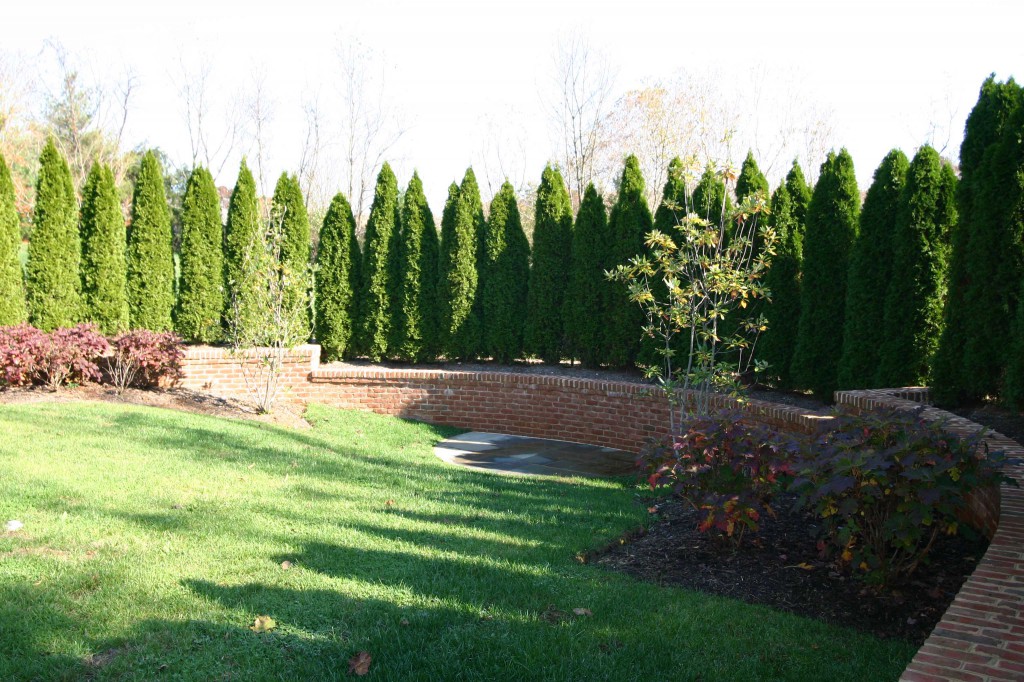
To me, these are a last resort. For one thing, a solid screen of one plant in a straight line is boring. Also, it can come off as a little antagonistic. A lush, mixed planting screen looks, from the Joneses’ side of the fence, like you’re doing some landscaping and beautification. A wall o’ green can be interpreted as the horticultural equivalent of getting up on a ladder and yelling “bite me, Jones!” while making obscene gestures. With both hands.
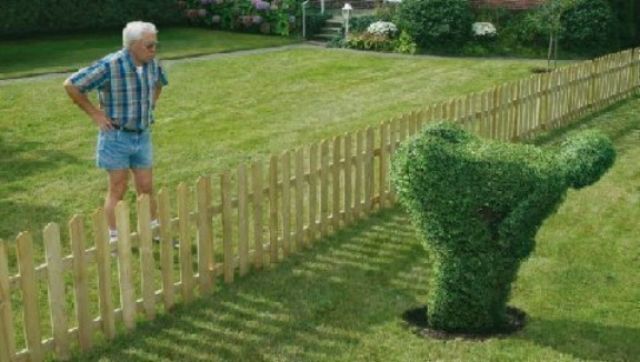
Does that mean evergreens are out? Heck no. Evergreens are a key component of any privacy planting. I just prefer to use them singly or in small groupings. The idea is to strategically locate the evergreens to address your biggest problems. If you feel like the neighbors’ kitchen window turns your pool deck into an amphitheatre, start there. Similarly, maybe you want to block the shed, or the neighboring patio, or the cars at the stop sign.
A word of caution: don’t make it too obvious that you’re screening one particular thing, or you’ll just draw attention to it. This park in Columbus, Ohio decided to “hide” the electrical equipment and now it’s almost impossible to look at anything else!
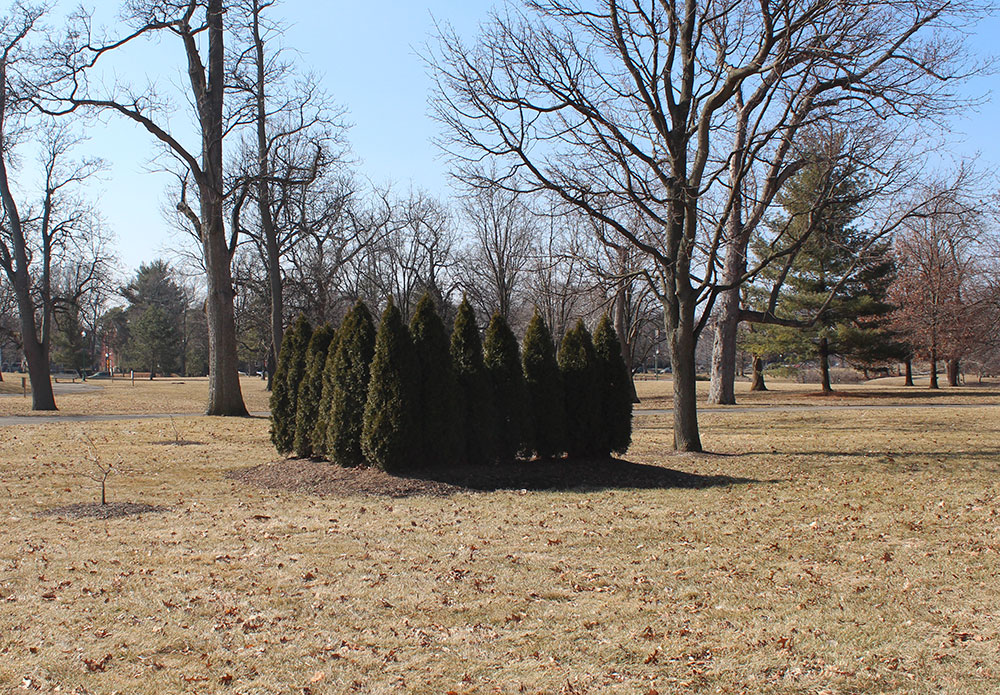
In many cases, this is enough to make you feel better and less like a fish in a bowl. Maybe you want to beef up the screening, though, so let’s go a step further.
2. Layer with deciduous trees for variety
Using deciduous trees when planting for privacy is smart for several reasons. If you’re trying to block out someone uphill or an upper story window, the right tree will grow up and block that out much more quickly than many evergreens. My backyard slopes down to the lowest point at the rear property line, then comes back up pretty quickly. Because we’re a corner lot, that meant sitting on my patio and staring at every car and pedestrian walking down the street. A grouping of river birch on the back fenceline have filled out beautifully and during the warm months, the street disappears.
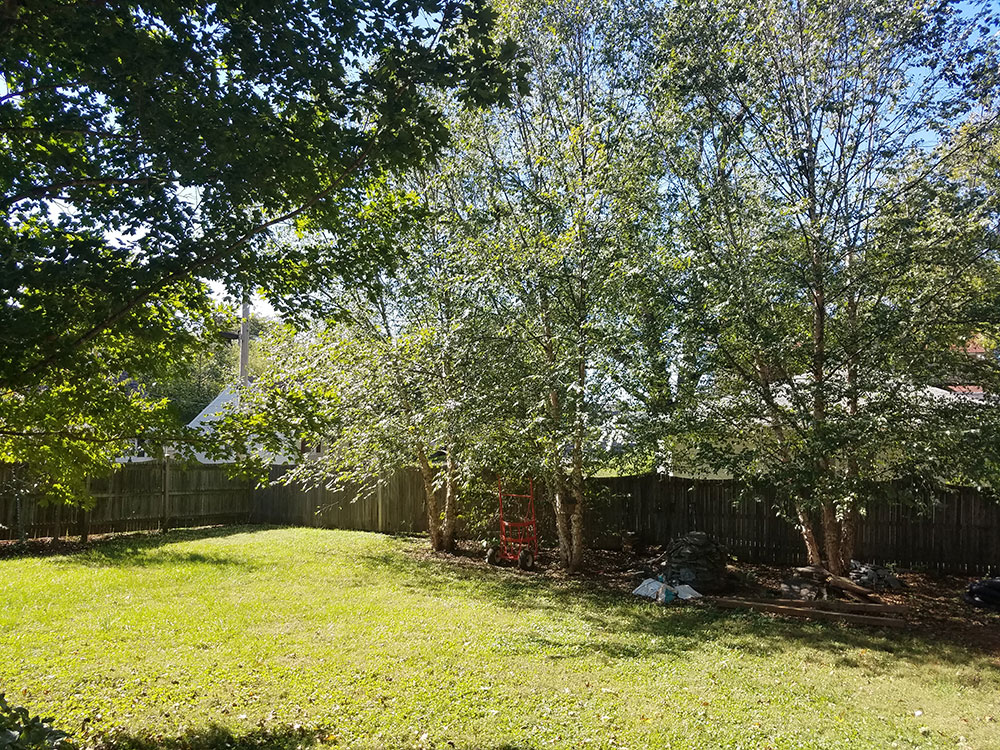
If you’re not blocking out something sitting higher than you, a big shade tree isn’t the way to go because over time, the canopy will be above where you actually need it. That still leaves you a lot of trees, though! Cherry trees are good filler trees in a privacy planting, especially because of the flower bonus. Ornamental/flowering trees are terrific, as are non-flowering trees like Zelkova.
3. The large shrub layer ties it all together
Much like an onion (or an ogre), a well-planned landscape has layers. The large shrub layer can fill in the gaps in that 5-10 foot range that your deciduous trees might leave. They can also soften the overall effect of your screening plantings by stepping the height down gradually and giving you something more interesting to look at. These can be large evergreen shrubs, or you can use deciduous shrubs. A lot will depend upon the amount of sun they’ll get, especially as the bigger plants begin to mature. You can see here how we layered a mix of evergreens (cryptomeria), deciduous trees (Kousa dogwood, crape myrtle, Zelkova), and large shrubs (primarily oakleaf and paniculata hydrangea) to help with the feeling of a private oasis in the Fredericksburg landscape design.
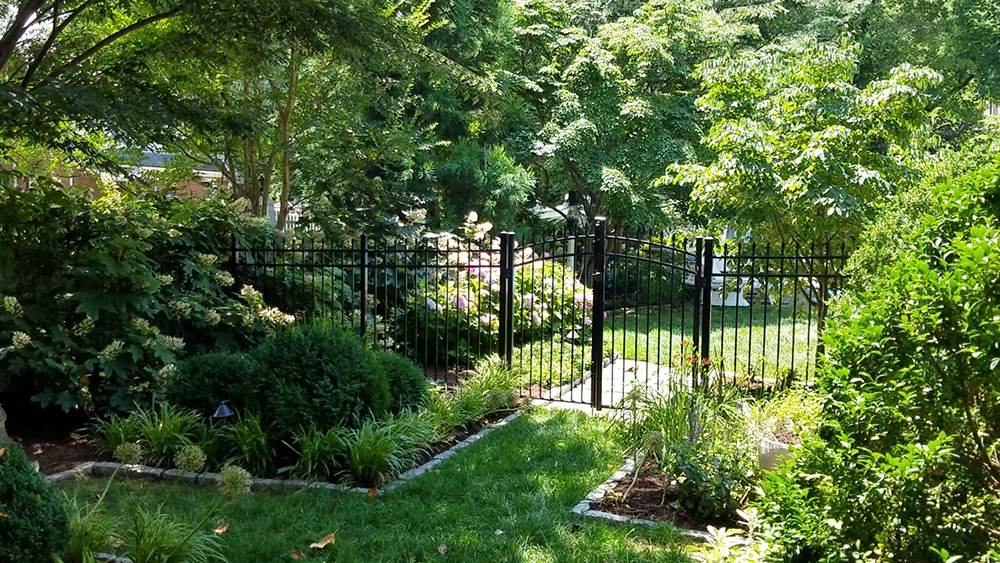
4. How deep is your love (for privacy plants)?
An important piece of the puzzle is deciding how deep (say, from the lawn edge to the fence) your planting bed can be. Every plant has a typical mature size, and you need to account for that. “Hold on, Dave,” you say, “shouldn’t you have brought this up as point #1?”
Nope, and there’s a darn good reason for it. Especially for folks who don’t do this for a living, it’s too easy to pick an arbitrary number that sounds right and everything needs to fit in that. That’s not how I design a screening plant bed. I start with the key elements I want to hide, figure out the best plant(s) for the job, and work back from there and see how much room I need to accomplish it. If we flat out don’t have the space required to do what the client wants, I can then go back to them and discuss alternatives. Alternatives like:
5. Sometimes it’s better to distract than to block
The great thing about people is that we’re all hard-wired pretty much the same. Landscape designers take advantage of this all the time to give people a little nudge: look here not there, walk this way, don’t miss that step, stop here, and so on. If I plant two columnar trees with space between, you’re naturally going to want to look between them. We call that framing a view, and if you want the neighbors to go away, it could be the wrong decision. It’s a design principle we call emphasis, and it can be surprisingly powerful.

On the other hand, maybe we can lead the eye away from the undesirable view. Rhythm is a principle of landscape design that can “push” the eye away from the gross RV that Bob keeps along the property line. There are many visual tricks you can use to distract from unpleasant views. Keep an eye out as you go about your day and pay attention to what you seem to look at almost automatically. For bonus points, look for things you’ve never noticed and try to see if there’s a design reason why you’ve never seen them. A good designer is always working.
6. Use Jedi mind tricks if space is tight
Every once in a while, especially in cities or their immediate suburbs, we have a situation where the client wants privacy but their house is so close to the property line that almost nothing fits. Sometimes, however, the neighbor they want to block has a good bit of space. If you have a decent relationship with your neighbor, you can sell them on putting screening trees that benefit YOU on THEIR property.

Does that sound crazy? Sure, a little, but we do it all the time. Homeowner A, who wanted the planting for privacy, pays for the plants and installation on Homeowner B’s property. It works because in many cases, if Homeowner A feels a need for privacy, so does Homeowner B. B just hasn’t done anything yet.
Are you looking for help creating your own privacy plantings and you’re not sure what to do? We’re here to help! Contact us today to learn more.

Live in Pinal County, Queen Creek Arizona. Not sure you can help but thought I would give it a try. Just moved into the retirement home:) house sits kitty corner to a north/south facing so 1 side of the house gets little to no sun. Want to plant a fast growing green shrub to block neighbors window directly looking into our living room. My wife and I do not like window coverings:).. all flowering shrubs here require at least 6 hours of sun. I thought green hopseed might be the ticket. Thoughts, ideas, suggestions?
Hey Jim, I am woefully unqualified to answer your question. If you haven’t already, I would reach out to your local county extension office. Extension is funded by land grant universities (in your case, U of A) and they support homeowners and not just agriculture. Here’s a link to their website https://extension.arizona.edu/pinal Best of luck, we lived in Chandler and I miss the heck out of AZ.